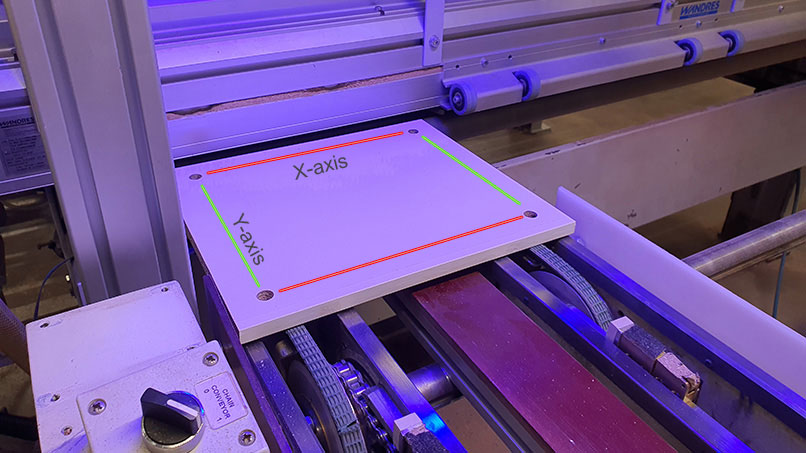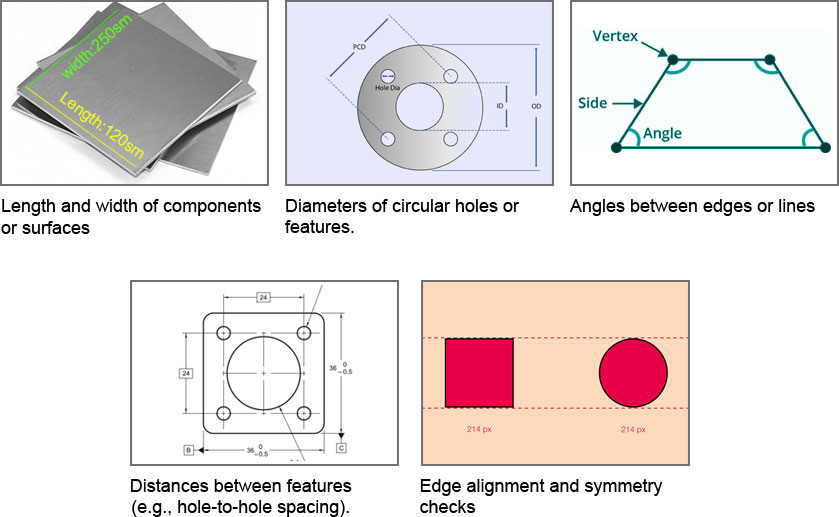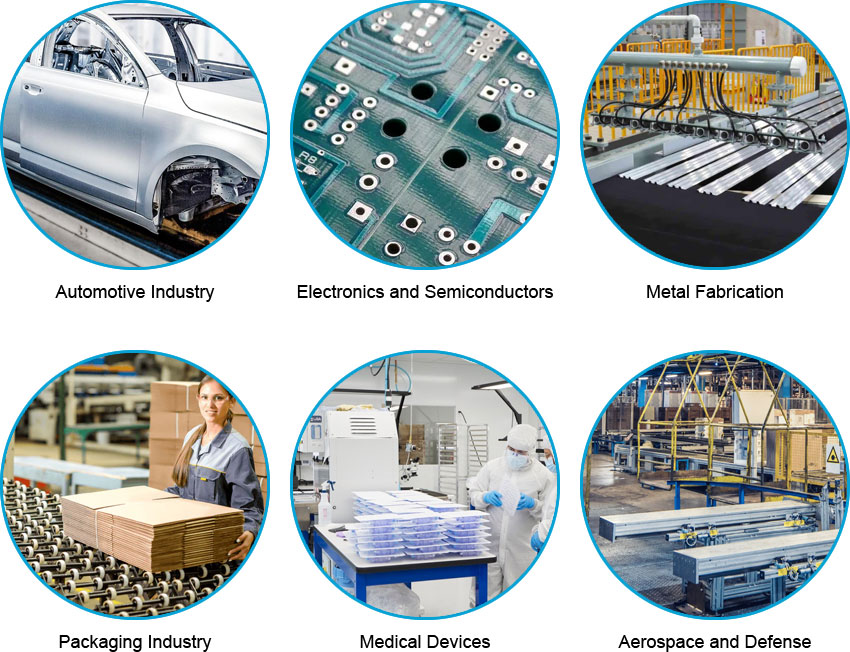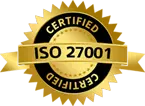What is 2D Measurement and How is it Automated with Machine Vision
Published on: Jun 18, 2025

Written by: Team Intelgic
What is 2D Measurement and How is it Automated with Machine Vision
In today’s fast-paced manufacturing environment, maintaining high precision and consistent product quality is more critical than ever. As industries demand tighter tolerances and faster production speeds, traditional manual measurement techniques are no longer sufficient. This is where 2D measurement systems powered by machine vision technology come into play.
2D measurement provides a reliable, non-contact method of inspecting critical geometric features on components, helping manufacturers detect dimensional deviations early in the process. When automated with machine vision, these systems offer unparalleled speed, accuracy, and repeatability—making them an essential part of modern industrial automation and quality control frameworks.
This article explores what 2D measurement entails and how it can be automated using a machine vision system to enhance quality assurance, reduce inspection time, and optimize production efficiency.

What is 2D Measurement?
2D measurement is the process of accurately determining the physical dimensions and spatial relationships of an object in a flat plane—specifically along the X-axis (horizontal) and Y-axis (vertical). Unlike 3D measurement, which considers depth as well, 2D measurement focuses solely on the surface dimensions that can be observed from a single viewpoint, typically from above. This method is essential for evaluating the geometrical properties of parts, such as their shape, size, and relative positioning of features.
In practical terms, 2D measurement allows for the precise calculation of important attributes, including:
- Length and width of components or surfaces.
- Diameters of circular holes or features.
- Angles between edges or lines.
- Distances between features (e.g., hole-to-hole spacing).
- Edge alignment and symmetry checks.
It is commonly applied in industries like automotive, electronics, metal fabrication, and packaging, where components must adhere to strict dimensional tolerances.

Automating 2D Measurement Using a Machine Vision System
A machine vision system enables the automation of 2D measurement tasks by using high-resolution machine vision cameras,sensors, lighting, and image processing algorithms. These systems are designed to capture images of objects and extract dimensional data with high speed and accuracy—minimizing manual inspection efforts and human error.
Here’s a step-by-step explanation of how 2D measurement is automated using machine vision:
1. Image Acquisition
The first and most critical step in automating 2D measurement is the acquisition of a high-quality image of the object being inspected. This image serves as the foundation upon which all subsequent measurement and analysis are built. To achieve this, a high-resolution industrial camera—carefully mounted in a fixed position relative to the object—is used to capture detailed visual data with minimal distortion or variation.
Camera Selection
Choosing the right camera is essential for ensuring measurement accuracy. Monochrome cameras are typically preferred in precision measurement applications because they offer superior resolution, better contrast sensitivity, and higher accuracy compared to color cameras. Without the interference of color filters, monochrome sensors can detect finer details and sharper edges, making them ideal for tasks such as edge detection, hole measurement, and linear dimensioning.
Lens Selection
Equally important is the selection of the appropriate lens. A telecentric lens is often used in 2D measurement systems to eliminate perspective distortion, which can occur when objects at different depths appear to change in size. Unlike conventional lenses, a telecentric lens ensures that all features of the object—regardless of their distance from the camera—appear at the same scale. This consistent magnification is crucial for obtaining accurate and repeatable measurements across the entire field of view.
2. Lighting: The Role of Backlighting in Accurate 2D Measurement
Proper lighting is critical in any machine vision system, especially for precision 2D measurement. Among various lighting techniques, backlighting is one of the most effective for achieving high accuracy.
How Backlighting Works:
In a backlighting setup, the light source is positioned behind the object, facing directly toward the camera. This arrangement causes the object to appear as a dark silhouette against a bright background. As a result, the edges of the object become sharply defined and highly contrasted.
Why Backlighting is Effective:
- Enhanced Edge Detection: The sharp contrast between the object and background allows image processing software to clearly detect and locate the object's outer edges with pixel-level precision.
- Consistent Results: Since the light passes through or around the object rather than reflecting off its surface, backlighting minimizes the effect of surface finish, color, or texture variations.
- Ideal for Transparent or Translucent Materials: Backlighting also works well for parts made from clear or semi-clear materials, revealing outlines that would otherwise be hard to detect with front lighting.
3. Calibration
Before accurate measurements can be taken, the vision system must be calibrated.
- A calibration target (grid or dot pattern) is placed under the camera to help map the pixel coordinates of the image to real-world units (e.g., millimeters).
- Lens distortion and perspective errors are compensated during this step, ensuring accurate spatial measurements.
4. AI Software for Image Processing and Measurement
Once the image is captured and the system is calibrated, advanced image processing software is used to analyze the visual data and extract precise geometric information.
- Preprocessing: The image is first optimized by adjusting brightness and contrast and removing visual noise. This step enhances the clarity of edges and improves the accuracy of downstream analysis.
- Edge Detection: Sophisticated algorithms like Canny, Sobel, or gradient-based filters are applied to identify the exact boundaries of the object. This ensures sharp edge localization, which is critical for reliable measurements.
- Feature Extraction: The software then detects and defines specific features such as holes, slots, lines, and contours. These features serve as reference points for dimensional evaluation.
- Geometric Measurements: Accurate measurements are performed between these identified features. Common measurements include:
- Hole-to-hole distance
- Radius or diameter of circular openings
- Width or height of components
- Angular alignment between edges or features
- Hole-to-hole distance
Through this structured process, the system transforms raw image data into precise, quantifiable geometric information, enabling consistent and automated quality control.
5. Tolerance Checking
The system compares the measured values to predefined engineering tolerances.
- If a measurement falls outside the acceptable range, the object is flagged as non-conforming.
- Based on this evaluation, the system can trigger real-time alerts, activate a rejection mechanism, or log the result in a database.
6. Result Output and System Integration
After completing the measurement and analysis, the machine vision system seamlessly communicates the results to the larger manufacturing infrastructure. The measured data can be transmitted to systems such as PLC (Programmable Logic Controller), SCADA, or MES (Manufacturing Execution System) for further processing.
This real-time data exchange enables:
- Automated sorting of conforming and non-conforming parts
- Robotic pick-and-place operations based on dimensional accuracy
- Statistical Process Control (SPC) for monitoring and improving production quality
By integrating with these systems, the vision solution becomes a key component of a fully automated, closed-loop manufacturing process, enhancing both productivity and quality assurance.

Advantages of Automated 2D Measurement Using Machine Vision AI
- Non-Contact Measurement: The system inspects parts without physical contact, making it ideal for measuring fragile, delicate, or high-temperature components that could be damaged by traditional contact methods.
- High Speed and Repeatability: Machine vision performs measurements within milliseconds and with consistent accuracy, making it perfectly suited for high-volume production environments where speed and reliability are critical.
- Micron-Level Precision: With advanced optics and processing algorithms, the system can achieve extremely high accuracy, often down to the micron scale, ensuring tight dimensional tolerances are maintained.
- Elimination of Human Error: Automated measurement removes the variability and fatigue associated with manual inspection, delivering consistent and objective results around the clock.
- Seamless Integration: These systems are designed to be easily integrated into existing automated production lines, with minimal disruption to workflow and high compatibility with industrial control systems.
- Real-Time Quality Control and Traceability: Measurement data can be monitored in real time, enabling immediate detection of defects and providing complete traceability throughout the production process, which is essential for maintaining product quality and regulatory compliance.
Applications in Various Industries
Automated 2D measurement systems powered by machine vision are widely adopted across industries where precision, speed, and consistency are critical. Below are some of the most common applications across key sectors:
1. Automotive Industry
- Inspection of stamped metal parts, gaskets, and brackets for dimensional accuracy
- Verification of hole placements and edge spacing in chassis and engine components
- Measuring alignment and position of automotive seals, trims, and fasteners
2. Electronics and Semiconductors
- Precision measurement of PCB (Printed Circuit Board) layouts, trace widths, and via locations
- Inspection of microelectronic components for spacing, orientation, and solder pad alignment
- Ensuring dimensional tolerances of connectors and casings at micron-level accuracy
3. Metal Fabrication
- Measurement of sheet metal parts, cut-outs, and punched holes
- Verification of contour shapes and edge alignment for laser-cut or stamped components
- Monitoring part deformation or warping during high-speed production
4. Packaging Industry
- Inspection of label placement, print registration, and cut dimensions
- Verification of packaging layouts for die-cut boxes, cartons, and blister packs
- Ensuring correct spacing and orientation of multi-part assemblies
5. Medical Devices
- Dimensional inspection of small, high-precision components such as surgical tools, implants, and tubing
- Measuring micro features in molded or machined medical parts
- Ensuring compliance with strict regulatory and safety standards
6. Aerospace and Defense
- Inspection of critical structural components for dimensional conformity
- Measuring machined parts and subassemblies with extremely tight tolerances
- Detecting positional deviations that could affect performance or safety

Intelgic: Advancing the Future of Automated 2D Measurement
Intelgic is a recognized leader in delivering advanced automated 2D measurement solutions that combine the power of machine vision, artificial intelligence, and precision optics. With a strong foundation in industrial automation, Intelgic provides intelligent systems that ensure high-speed, high-accuracy inspection tailored to modern manufacturing environments.
What Sets Intelgic Apart
- AI-Enhanced Vision Software
Intelgic’s proprietary software integrates AI-driven algorithms to enhance image processing, improve edge clarity, and adapt dynamically to complex part geometries—ensuring reliable and repeatable measurements across varying production conditions.
- Custom-Engineered Solutions
Understanding that every manufacturing process has unique requirements, Intelgic designs customized 2D measurement systems that integrate seamlessly into existing production lines, whether for inline inspection, robotic guidance, or automated sorting.
- Precision Hardware Integration
By utilizing high-resolution industrial cameras, telecentric lenses, and optimized lighting techniques such as backlighting, Intelgic delivers systems capable of micron-level measurement accuracy, even in high-speed, high-volume environments.
- Real-Time Data Communication and Traceability
Intelgic systems are designed for real-time connectivity with PLCs, SCADA, and MES platforms. This allows for immediate response to measurement deviations and supports end-to-end traceability, which is essential for quality assurance and regulatory compliance.
- User-Centric Interface and Comprehensive Support
The systems feature intuitive, operator-friendly interfaces for easy setup, monitoring, and control. Intelgic also provides full lifecycle support—from consultation and system design to implementation, training, and maintenance.
Automated 2D measurement using machine vision has become an essential part of modern manufacturing, offering unmatched speed, precision, and consistency in quality control. From automotive and electronics to medical devices and packaging, this technology ensures that dimensional accuracy is maintained across high-volume production environments.
By combining cutting-edge optics, AI-powered software, and seamless integration with industrial control systems, machine vision delivers a non-contact, highly efficient alternative to traditional measurement methods. It not only reduces human error and inspection time but also enables real-time monitoring and data-driven decision-making.
As a leading innovator in this space, Intelgic continues to push the boundaries of what's possible—helping industries achieve higher quality standards, reduce operational costs, and stay competitive in an increasingly automated world.

